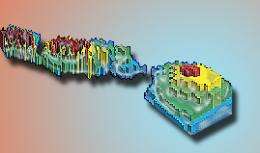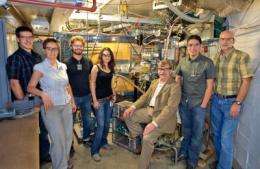Superheavy Element 114 Confirmed: A Stepping Stone to the Island of Stability

(PhysOrg.com) -- Scientists at the U.S. Department of Energy's Lawrence Berkeley National Laboratory have been able to confirm the production of the superheavy element 114, ten years after a group in Russia, at the Joint Institute for Nuclear Research in Dubna, first claimed to have made it. The search for 114 has long been a key part of the quest for nuclear science's hoped-for Island of Stability.
Heino Nitsche, head of the Heavy Element Nuclear and Radiochemistry Group in Berkeley Lab's Nuclear Science Division (NSD) and a professor of chemistry at the University of California at Berkeley, and Ken Gregorich, a senior staff scientist in NSD, led the team that independently confirmed the production of the new element, which was first published by the Dubna Gas Filled Recoil Separator group.
Using an instrument called the Berkeley Gas-filled Separator (BGS) at Berkeley Lab's 88-Inch Cyclotron, the researchers were able to confirm the creation of two individual nuclei of element 114, each a separate isotope having 114 protons but different numbers of neutrons, and each decaying by a separate pathway.
"By verifying the production of element 114, we have removed any doubts about the validity of the Dubna group's claims," says Nitsche. "This proves that the most interesting superheavy elements can in fact be made in the laboratory."
Verification of element 114 is reported in Physical Review Letters. In addition to Nitsche and Gregorich, the Berkeley Lab team included Liv Stavestra, now at the Institute of Energy Technology in Kjeller, Norway; Berkeley Lab postdoctoral fellow Jan Dvořák; and UC graduate students Mitch Andrē Garcia, Irena Dragojević, and Paul Ellison, with laboratory support from UC Berkeley postdoctoral fellow Zuzana Dvořáková.
The realm of the superheavy
Elements heavier than uranium, element 92 - the atomic number refers to the number of protons in the nucleus - are radioactive and decay in a time shorter than the age of Earth; thus they are not found in nature (although traces of transient neptunium and plutonium can sometimes be found in uranium ore). Elements up to 111 and the recently confirmed 112 have been made artificially - those with lower atomic numbers in nuclear reactors and nuclear explosions, the higher ones in accelerators - and typically decay very rapidly, within a few seconds or fractions of a second.
Beginning in the late 1950s, scientists including Gertrude Scharff-Goldhaber at Brookhaven and theorist Wladyslaw Swiatecki, who had recently moved to Berkeley and is a retired member of Berkeley Lab's NSD, calculated that superheavy elements with certain combinations of protons and neutrons arranged in shells in the nucleus would be relatively stable, eventually reaching an "Island of Stability" where their lifetimes could be measured in minutes or days - or even, some optimists think, in millions of years. Early models suggested that an element with 114 protons and 184 neutrons might be such a stable element. Longtime Berkeley Lab nuclear chemist Glenn Seaborg, then Chairman of the Atomic Energy Commission, encouraged searches for superheavy elements with the necessary "magic numbers" of nucleons.
"People have been dreaming of superheavy elements since the 1960s," says Gregorich. "But it's unusual for important results like the Dubna group's claim to have produced 114 to go unconfirmed for so long. Scientists were beginning to wonder if superheavy elements were real."
To create a superheavy nucleus requires shooting one kind of atom at a target made of another kind; the total protons in both projectile and target nuclei must at least equal that of the quarry. Confirming the Dubna results meant aiming a beam of 48Ca ions - calcium whose nuclei have 20 protons and 28 neutrons - at a target containing 242Pu, the plutonium isotope with 94 protons and 148 neutrons. The 88-Inch Cyclotron's versatile Advanced Electron Cyclotron Resonance ion source readily created a beam of highly charged calcium ions, atoms lacking 11 electrons, which the 88-Inch Cyclotron then accelerated to the desired energy.
Four plutonium oxide target segments were mounted on a wheel 9.5 centimeters (about 4 inches) in diameter, which spun 12 to 14 times a second to dissipate heat under the bombardment of the cyclotron beam.
"Plutonium is notoriously difficult to manage," says Nitsche, "and every group makes their targets differently, but long experience has given us at Berkeley a thorough understanding of the process." (Experience is especially long at Berkeley Lab and UC Berkeley - not least because Glenn Seaborg discovered plutonium here early in 1941.)
When projectile and target nuclei interact in the target, many different kinds of nuclear reaction products fly out the back. Because nuclei of superheavy elements are rare and short-lived, both the Dubna group and the Berkeley group use gas-filled separators, in which dilute gas and tuned magnetic fields sweep the copious debris of beam-target collisions out of the way, ideally leaving only compound nuclei with the desired mass to reach the detector. The Berkeley Gas-filled Separator had to be modified for radioactive containment before radioactive targets could be used.
In sum, says Gregorich, "The high beam intensities from the 88-Inch Cyclotron, together with the efficient background suppression of the BGS, allow us to look for nuclear reaction products with very small cross-sections - that is, very low probabilities of being produced. In the case of element 114, that turned out to be just two nuclei in eight days of running the experiment almost continuously."

Tracking the isotopes of 114
The researchers identified the two isotopes as 286114 (114 protons and 172 neutrons) and 287114 (114 protons and 173 neutrons). The former, 286114, decayed in about a tenth of a second by emitting an alpha particle (2 protons and 2 neutrons, a helium nucleus) - thus becoming a "daughter" nucleus of element 112 - which subsequently spontaneously fissioned into smaller nuclei. The latter, 287114, decayed in about half a second by emitting an alpha particle to form 112, which also then emitted an alpha particle to form daughter element 110, before spontaneously fissioning into smaller nuclei.
The Berkeley Group's success in finding these two 114 nuclei and tracking their decay depended on sophisticated methods of detection, data collection, and concurrent data analysis. After passing through the BGS, the candidate nucleus enters a detector chamber. If a candidate element 114 atom is detected, and is subsequently seen to decay by alpha-particle emission, the cyclotron beam instantly shuts off so further decay events can be recorded without background interference.
In addition to such automatic methods of enhancing data collection, the data was analyzed by completely independent software programs, one written by Gregorich and refined by team member Liv Stavsetra, another written by team member Jan Dvořák.
"One surprise was that the 114 nuclei had much smaller cross sections - were much less likely to form - than the Dubna group reported," Nitsche says. "We expected to get about six in our eight-day experiment but only got two. Nevertheless, the decay modes, lifetimes, and energies were all consistent with the Dubna reports and amply confirm their achievement."
Says Gregorich, "Based on the ideas of the 1960s, we thought when we got to element 114 we would have reached the Island of Stability. More recent theories suggest enhanced stability at other proton numbers, perhaps 120, perhaps 126. The work we're doing now will help us decide which theories are correct and how we should modify our models."
Nitsche adds, "During the last 20 years, many relatively stable isotopes have been discovered that lie between the known heavy element isotopes and the Island of Stability - essentially they can be considered as 'stepping stones' to this island. The question is, how far does the Island extend - from 114 to perhaps 120 or 126? And how high does it rise out the Sea of Instability."
The accumulated expertise in Berkeley Lab's Nuclear Science Division; the recently upgraded Berkeley Gas-filled Separator that can use radioactive targets; the more powerful and versatile VENUS ion source that will soon come online under the direction of operations program head Daniela Leitner - all add up to Berkeley Lab's 88-Inch Cyclotron remaining highly competitive in the ongoing search for a stable island in the sea of nuclear instability.
More information: "Independent verification of element 114 production in the 48Ca + 242Pu reaction," by L. Stavestra, K. Gregorich, J. Dvořák, P. A. Ellison, I. Dragojević, M. A. Garcia, and H. Nitsche, appears in Physical Review Letters 103, 132502 and is available online at link.aps.org/doi/10.1103/PhysRevLett.103.132502 .
Source: Lawrence Berkeley National Laboratory (news : web)



















